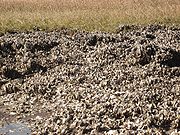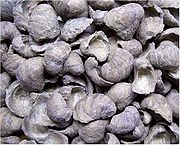
Pycnodonte newberryi
Encyclopedia
Pycnodonte newberryi is a species in the Pycnodonte
genus
of extinct oyster
s, marine
bivalve mollusks in the family
Gryphaeidae
. It lived from the Cretaceous period, 90 to 130 million years old. P. newberryi fossils generally exist in large layers or beds. In the state of Utah
, in the USA, in the Capital Reef National Park area, this layer of fossils ranges up to ten feet thick. The layer is present in the lower Tununk section of the Mancos Shale
Fraction, just above the Dakota Sandstone
and below the Blue Gate Shale layer. In the Hanksville, Utah
area the Pycnodonte newberryi oyster bed is exposed over a large area. Studies are currently being conducted to determine if there is more than one species in these beds.


Pycnodonte
Pycnodonte is a genus of extinct oysters, marine bivalve mollusks in the family Gryphaeidae. They are found around the world in fossil shell beds from the Valanginian to Early Pleistocene...
genus
Genus
In biology, a genus is a low-level taxonomic rank used in the biological classification of living and fossil organisms, which is an example of definition by genus and differentia...
of extinct oyster
Oyster
The word oyster is used as a common name for a number of distinct groups of bivalve molluscs which live in marine or brackish habitats. The valves are highly calcified....
s, marine
Marine (ocean)
Marine is an umbrella term. As an adjective it is usually applicable to things relating to the sea or ocean, such as marine biology, marine ecology and marine geology...
bivalve mollusks in the family
Family (biology)
In biological classification, family is* a taxonomic rank. Other well-known ranks are life, domain, kingdom, phylum, class, order, genus, and species, with family fitting between order and genus. As for the other well-known ranks, there is the option of an immediately lower rank, indicated by the...
Gryphaeidae
Gryphaeidae
Gryphaeidae, common name the foam oysters or honeycomb oysters, is a family of marine bivalve mollusks, related to the true oysters.-Taxonomy:...
. It lived from the Cretaceous period, 90 to 130 million years old. P. newberryi fossils generally exist in large layers or beds. In the state of Utah
Utah
Utah is a state in the Western United States. It was the 45th state to join the Union, on January 4, 1896. Approximately 80% of Utah's 2,763,885 people live along the Wasatch Front, centering on Salt Lake City. This leaves vast expanses of the state nearly uninhabited, making the population the...
, in the USA, in the Capital Reef National Park area, this layer of fossils ranges up to ten feet thick. The layer is present in the lower Tununk section of the Mancos Shale
Mancos Shale
The Mancos Shale or Mancos Group is an Upper Cretaceous geologic formation of the Western United States dominated by mudrock that accumulated in offshore and marine environments of the Cretaceous North American Inland Sea. The Mancos was deposited during the Cenomanian through Campanian ages,...
Fraction, just above the Dakota Sandstone
Dakota Sandstone
The Dakota Sandstone is a general term for an ill-defined early Cretaceous formation of the Rocky Mountains and Great Plains. It consists of sandy, shallow-marine deposits with intermittent mud flat sediments, and occasional stream deposits...
and below the Blue Gate Shale layer. In the Hanksville, Utah
Hanksville, Utah
Hanksville is a small town in Wayne County, Utah, United States, at the junction of State Routes 24 and 95. The town is just south of the confluence of the Fremont River and Muddy Creek, which together form the Dirty Devil River, which then flows southeast to the Colorado River...
area the Pycnodonte newberryi oyster bed is exposed over a large area. Studies are currently being conducted to determine if there is more than one species in these beds.



